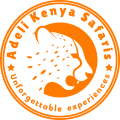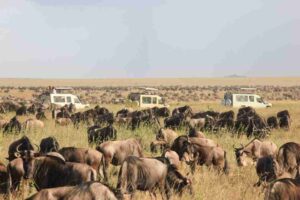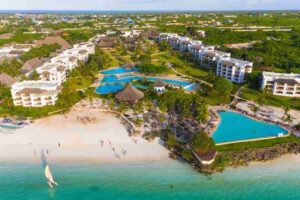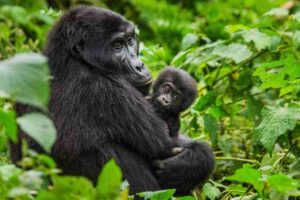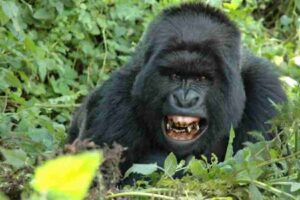| Name of the facility | Porini Amboseli Camp |
|---|---|
| Certification Achieved | Gold |
| Year opened | 1997 |
| Tourism region | Tsavo/Amboseli |
| County | Kajiado |
| Address | Head Office – Nairobi Map It |
| Telephone/Mobile | + 254 20 7123129 |
| [email protected] | |
| Website | porini.com |
| Facility Notes | Porini Amboseli Camp is located in Selenkay Conservancy, North of Amboseli National Park. The camp is specifically located on Global Positioning System (GPS) Coordinates, Latitude: 2.33955 (2°20′22.382″S) and Longitude: 37.30487 (37°18′17.524″E). It has 9 guest tents with a bed capacity of 18 visitors and a total work force of 30 employees. The land in which the facility is located measures approximately 12, 350 acres and is an important dispersal area and rangeland for wildlife migrating out of Amboseli. Selenkay Conservancy lies North of Amboseli National Park forming an important dispersal area and rangeland for wildlife migrating out of Amboseli. The conservancy was formulated in 1997, through an agreement between Porini camp and the local Maasai community to set aside their land for environmental conservation and wildlife protection. In return, the community receives land lease payments and bed night fees for each visitor. The conservancy is home to wildlife including: elephant, lion, leopard, cheetah, Thompson’s and Grant’s gazelles, gerenuk, impala, oryx, lesser kudu, zebra, wildebeest, giraffe, warthog, striped hyena, jackal, bat-eared fox, caracal, African wild cat, serval cat, genet cat, honey badger, mongoose and ostrich. It is a haven for birdlife, especially birds of prey. |
| Energy management | The source of power for the camp is solar energy. Each guest tent is fixed with an individual panel and backup battery to supply light to the camp. An additional centralized and metered backup solar energy system is in place. The power is used for lighting and running the camp refrigerants / freezers. Guests are encouraged to charge their cameras in the game drive vehicles. Energy saving bulbs is installed throughout to enhance energy conservation. The camp has one (1) energy efficient kuni boiler used for water heating. It is run on sustainably obtained fuel wood. For that uses charcoal briquettes. The facility has a charcoal cooler ‘fridge’ for storing fruits and vegetables. Liquefied Petroleum gas (LPG) is used for guests cooking whereas fuel-wood – sustainably obtained eucalyptus from Kakuzi is used for staff cooking. |
| Environmental management | The camp is guided by its corporate environmental policy showing commitment to responsible and sustainable tourism, nature conservation, improving local communities’ wellbeing, and raising awareness among tourists. Further, the policy addresses the impact and management of the land, water, energy, sewage and solid wastes. The facility has an environmental management system (EMS) to spearhead its operations. The EMS includes panning for impact reduction, implementation and operation, monitoring (checking) and management review. It has undertaken its annual self-Environmental Audit (EA) as required by EMCA 1999 (Environmental Management and Co-ordination Act). |
| Chemical use | The camp uses Ubuntu Organic Soaps biodegradable solutions for cleaning. The chemicals are accompanied by a Material Safety Data Sheet. (MSDS). Laundry for the camp is done in Nairobi. Liquefied Petroleum gas is stored in 50 kg, and 12kg cylinders. Fuel i.e. diesel is stored in 200 litres containers in a properly secured store. |
| Conservation Criteria | |
| Community Criteria | |
| Solid waste management | Waste separation is conducted at source. Organic waste is composted. Plastics, metallic waste (tins), glass (wine bottles are put in large containers waiting disposal via Nairobi Gamewatchers Stores to Taka Kenya – a waste management and recycling firm. A waste disposal tracking form has been established to ensure the waste (from the camp) is delivered to the intended destination in Nairobi. The camp uses 18 litre drinking water dispensers for guests and staff aimed at plastic waste reduction. Decorated i.e. beaded wine bottles are used to serve water at the guest tents – an initiative to reduce on plastic waste. The camp provides re-usable aluminum bottles for use by the guests while at the camp. This initiative is aimed at awareness creation to clients and plastic waste reduction. |
| Water management | The main source of water for the camp is obtained from a borehole. The water is pumped through solar power and collected in a reservoir of 20,000 litres for supply through gravitational force to the entire premises. Water is metered at source and recording done to monitor its consumption. Further the facility has installed rainwater harvesting tanks within the premises to boost on borehole water. The camp uses safari showers (20 litre buckets) within the guest tents – an initiative to reduce on water used. The camp has established a routine reporting procedure to monitor any water leakages. The efforts are spearheaded by the repairs & maintenance (R&M) team. The guest tents are fixed with water efficient dual flash toilet cisterns. The camp has a reverse osmosis treatment plant for kitchen use and staff water drinking. This has immensely reduced on bottled water usage. |
| Visitor communication & education | Guests are briefed upon arrival by the manager on the existing activities of the camp and environmental conservation such as on water. A room leaflet is strategically placed on the guest bed with elaborate information on the water, energy and waste management and community integration. The camp guest rooms are equipped with elaborate room information folders and nature magazines. Room information folders contain available activities within the camp and operations within Selenkay Conservancy. Further it illustrates on the uniqueness of conservancy with detailed information on community projects, conservation activities and guests involvements. Visitors are given an opportunity to engage and interact with local conservation initiatives such as Elephant Research Centre, Living with the Lions etc. The guests are offered visits to the research centers in the area. Pamphlets are also put in the guest tents for visitors’ information. Checklist on birds and mammals, is also available. |
| Pollution | Solar lanterns are used for lighting the pathways at night. This reduces on light emission and pollution at night. |
| Environmental conservation | The camp is built and operates on low impact, limited to 18 guests at a time. The guest tents and staff quarters are made out of beige and green canvas tents that blends in with the surroundings. Natural vegetation within is relatively undisturbed. Paths ways are naturally aligned with sand to demarcate the way. It conducts low environmental impact activities such as bird watching, nature walks and village visits for its visitors within the conservancy. The activities are aimed at sensitizing the visitors on the surrounding environment. The camp forms part of the conservancy management. It has employed 25 community rangers for patrols and operations of the conservancy. Through Selenkay Conservancy, and Eselenkei Group Ranch; the camp supports ‘Living with Lions’ predator project. It has provided a research camp within the conservancy and are assists by directly employing one Lion Guardian since November 2010 spending approximately USD 1,300 per annum. Through the conservancy rangers, the camp works closely with Biglife Foundation in wildlife monitoring, poaching prevention and reporting on injured wildlife incidences. Guests at the camp pay bed night and conservancy fees which is used in conservation activities in the conservancy. ‘Red filter lights’ are used to during night game drives – an initiative aimed at minimal interference of wildlife at night. |
| Waste water management | All grey water from the kitchen, guest rooms and staff quarters is managed via soak pits. The facility has 9 soak pits. The kitchen effluent system has grease traps to filter out oils and grease. Black water from the guest rooms and public areas is managed through septic tanks. The facility has two (2) main septic tanks. There are (2) long drop toilets in use at staff quarters. |
| Purchasing and supplies | The facility purchases its products in bulk to reduce on packaging; fruits and vegetables are packed in re-usable crates whereas meat is packaged in cool boxes. |
| Employment and remuneration/staff welfare | Staff is provided with, health care, uniform, food, accommodation facilities and basic amenities such as soaps, lotions, washing powder etc. Being in a remote area, all the staff are registered on mobile banking for easier transfer of their salaries. Additionally, they are registered with Kentours Sacco. Staff committee is established on an age perspective where senior elders spearhead the staff welfare issues. |
| Staff education, communication and awareness training | The camp has 6 guides who are certified under the Kenya Professional Safari Guides Association: (KPSGA) one (2) silver and (4) Bronze. The camp has an in-house staff training program. Employees working at the camp are trained in-house by the company. Staff briefings are held on daily basis for planning and operations activities. |
| Cultural preservation and promotion/protection of local sites | The facility has designated a curio shop within the camp where guests can purchase curios and artefacts. The Curio shop is fully operated and managed by the local community. As a result of the rich cultural values, the camp is only managed by male. Women on the other hand benefit from curios and beads making. Visitors within the facility are offered local village visits. The system in organized in such a way no cash payments is exchanged. Instead the local people are paid on monthly basis depending on the number of guests visiting the village. Each guest pays KSh. 1000 whereas children are charged at KSh. 500. Village visits include cultural talks by the local elders, and entertainment such as cultural dances. |
| Benefits to local community/community empowerment | Local purchasing is made where possible. On weekly basis; the camp purchases a goat for staff from the local people (4 to 7 goats on monthly basis). A group of women from the area also supply honey. More than 94% of the staff is employed from the local community. The employees are trained internally by the camp management. The camp contributes lease fees Kshs. 906,000/- per quarter paid to community group. Kshs. 1,100/- per person per night is contributed and paid at the end of every month. 20% goes directly to the Eselenkei Group Ranch Officials; 30% to the Eselenkei Trust Fund (which contributes toward school fees of needy children, community barazas and animal compensation for predation); and lastly 50 % for project development. The camp has an elaborate Corporate Social responsibility (CSR) Plan with a designate person to spearhead it. It engages in various initiatives, these include education, health, community projects and conservation initiatives. • Education; the camp support various schools within and surrounding the Selenkay conservancy. The schools are Lenkisem Secondary, Iloilero Primary and Ituleta Primary School. In Lenkisem Secondary and Iloilero Primary, the Camp makes donations such as textbooks, stationary, and sports equipment. • Energy; Through partnership with the camp, GIVEWATTS – a clean energy provision company, installed a full solar system that provides light in three classrooms at Iloilero School. Additionally, the company supplied standard 7 and 8 school going pupils at Iloilero School with solar lights. • Water; the camp ensures maintenance of a water pan (dredged by the camp) for water provision to the conservancy livestock. The camp also provides water for household use through a bowser (camp vehicle) to two villages in proximity to it. The water is provided twice a week and stored in 3, 500 litre reservoirs. Four boreholes within the larger Esenlenkei Group Ranch are also under Porini repairs and maintenance schedule. The camp has employed a full time employee specifically for this. In two boreholes the camp has installed solar powered pumps. Other repairs include maintenance of the diesel powered generators. • Conservation education; the camp offers game drives to best candidates (position 1 to 3) form the surrounding schools. An initiative aimed at raising awareness on conservation. • Roads maintenance; through the conservancy, the camp ensures maintenance of the roads in Selenkay. |
| Cultural Criteria | |
| Health and safety | The camp has a health and safety policy committed to compliance with relevant health and safety regulations, minimizing injuries and illness, communication to staff and visitors for continual improvement. The facility has a team of 27 staff trained on general first aid and firefighting. In addition, it has a doctor on call from the region. Medical emergencies are referred to Machakos and Makindu hospitals. Staff are attended at Fatima Health Centre and costs covered by the camp. Adequate first aid kits are available within the camp. The first aid boxes were assessed and found to comply with the First Aid Rules (Legal Notice No. 160 of 1977). Further it has an airstrip for medical evacuation and it is linked to AAR and AMREF for air emergency evacuation. The camp has a Health Clearance Certificate from the Ministry of Public Health and Sanitation. Medical check-ups are conducted in every six (6) months to food and beverage handlers to ascertain their health fitness, and in compliance with the Food, Drugs, and Chemical substances Act. Cap 254. Adequate firefighting equipment including, fire extinguishers, fire blanket in the kitchen, are serviced. The facility provides protective gear / PPE (Personal Protective Equipment) such as boots, uniform, gloves, apron to the staff. Guest tents are equipped with a night flush light and a fire alarm is in place. Fire assembly point is clearly and conspicuously marked within the camp. The camp has safety and precautionary signage such as, highly flammable in strategic areas such as diesel storage room. The camp conducts a fire safety audit to comply with Factories and other places of work (Fire Risk Reduction) Rules 2007. It also conducts a safety and Health Audit to comply with the Occupational Safety and Health Act, 2007. |
| Child labor, abuse and human rights | The facility adheres to the legal employment age. |
| Business Practises Criteria | |
| Entry Date | 10th November 2017 |
Porini Amboseli Camp
Book best Africa Luxury Safaris in Kenya & East Africa explore best wildlife parks,, wildebeest migration, big five, big cats, cultures, beaches & natural wonders
Table of Contents
Why Go with Adeli Kenya Safaris
- Born, raised & based in Africa. Let u show you the Africa we know well and cherish so much
- Africa sustainable travel is our passion
- Great Value for Money. Best price guaranteed
- Experienced team of travel experts
- Knowledgeable & multi-lingual safari guides
- Safety conscious
- Fleet of well maintained vehicles
Your dream safari / holiday is just a call or email away. Contact Adeli Kenya Safaris today. Tel: +254720564538 | WhatsApp: +254720564538 | Email: [email protected]
